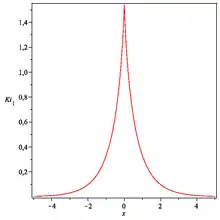Fonction de Bickley-Naylor
Définition
Fonction Ki1 de Bickley-Naylor. La fonction de Bickley-Naylor d'ordre n est définie par
K
i
n
(
x
)
=
∫
0
π
2
e
−
x
sin
θ
sin
n
−
1
θ
d
θ
{\displaystyle \mathrm {Ki} _{n}(x)=\int _{0}^{\frac {\pi }{2}}\mathrm {e} ^{-{\frac {x}{\sin \theta }}}\sin ^{n-1}\theta \,\mathrm {d} \theta }
Cette fonction est reliée à la fonction G de Meijer (en) [2] transformation de Mellin .
Définitions alternatives Les formes suivantes donnent la même fonction :
K
i
n
(
x
)
=
∫
0
π
2
e
−
x
cos
θ
cos
n
−
1
θ
d
θ
{\displaystyle \mathrm {Ki} _{n}(x)=\int _{0}^{\frac {\pi }{2}}\mathrm {e} ^{-{\frac {x}{\cos \theta }}}\cos ^{n-1}\theta \,\mathrm {d} \theta }
K
i
n
(
x
)
=
∫
0
+
∞
e
−
x
cosh
t
cosh
n
−
1
t
d
t
{\displaystyle \mathrm {Ki} _{n}(x)=\int _{0}^{+\infty }{\frac {\mathrm {e} ^{-x\cosh t}}{\cosh ^{n-1}t}}\,\mathrm {d} t}
K
i
n
(
x
)
=
∫
1
+
∞
e
−
x
t
t
n
t
2
−
1
d
t
{\displaystyle \mathrm {Ki} _{n}(x)=\int _{1}^{+\infty }{\frac {\mathrm {e} ^{-xt}}{t^{n}{\sqrt {t^{2}-1}}}}\,\mathrm {d} t}
K
i
n
(
x
)
=
1
(
n
−
1
)
!
∫
x
+
∞
(
x
−
t
)
n
−
1
K
0
(
t
)
d
t
{\displaystyle \mathrm {Ki} _{n}(x)={\frac {1}{(n-1)!}}\int _{x}^{+\infty }(x-t)^{n-1}K_{0}(t)\,\mathrm {d} t}
K
i
n
(
x
)
=
x
n
(
n
−
1
)
!
∫
1
+
∞
(
x
−
1
)
n
−
1
K
0
(
x
t
)
d
t
{\displaystyle \mathrm {Ki} _{n}(x)={\frac {x^{n}}{(n-1)!}}\int _{1}^{+\infty }(x-1)^{n-1}K_{0}(xt)\,\mathrm {d} t}
Dans les deux dernières définitions, K 0 (t )fonction de Bessel modifiée d'ordre 0. On en déduit que Ki0 = K 0 .
Développement en série On connait le développement en série entière des deux premières fonctions de Bickley-Naylor :
Ki
1
(
x
)
=
π
2
+
x
(
γ
+
ln
(
x
2
)
)
∑
k
=
0
∞
(
x
2
/
4
)
k
(
k
!
)
2
(
2
k
+
1
)
−
x
∑
k
=
0
∞
(
x
2
/
4
)
k
(
k
!
)
2
(
2
k
+
1
)
2
−
x
∑
k
=
1
∞
(
x
2
/
4
)
k
H
k
(
k
!
)
2
(
2
k
+
1
)
{\displaystyle \operatorname {Ki} _{1}(x)={\frac {\pi }{2}}+x\left(\gamma +\ln \left({\frac {x}{2}}\right)\right)\sum _{k=0}^{\infty }{\frac {(x^{2}/4)^{k}}{(k!)^{2}(2k+1)}}-x\sum _{k=0}^{\infty }{\frac {(x^{2}/4)^{k}}{(k!)^{2}(2k+1)^{2}}}-x\sum _{k=1}^{\infty }{\frac {(x^{2}/4)^{k}H_{k}}{(k!)^{2}(2k+1)}}}
Ki
2
(
x
)
=
1
−
π
2
x
−
x
2
2
(
γ
+
ln
(
x
2
)
)
∑
k
=
0
∞
(
x
2
/
4
)
k
k
!
(
k
+
1
)
!
(
2
k
+
1
)
+
x
2
4
∑
k
=
0
∞
(
4
k
+
3
)
(
x
2
/
4
)
k
k
!
(
k
+
1
)
!
(
2
k
+
1
)
2
+
x
2
2
∑
k
=
1
∞
(
x
2
/
4
)
k
H
k
k
!
(
k
+
1
)
!
(
2
k
+
1
)
{\displaystyle \operatorname {Ki} _{2}(x)=1-{\frac {\pi }{2}}x-{\frac {x^{2}}{2}}\left(\gamma +\ln \left({\frac {x}{2}}\right)\right)\sum _{k=0}^{\infty }{\frac {(x^{2}/4)^{k}}{k!(k+1)!(2k+1)}}+{\frac {x^{2}}{4}}\sum _{k=0}^{\infty }{\frac {(4k+3)(x^{2}/4)^{k}}{k!(k+1)!(2k+1)^{2}}}+{\frac {x^{2}}{2}}\sum _{k=1}^{\infty }{\frac {(x^{2}/4)^{k}H_{k}}{k!(k+1)!(2k+1)}}}
avec γ est la constante d'Euler-Mascheroni et Hk est le k e nombre harmonique .
Relations de récurrence Récurrence Les fonctions de Bickley-Naylor vérifient la relation de récurrence[3]
n
Ki
n
+
1
(
x
)
=
(
n
−
1
)
Ki
n
−
1
(
x
)
−
x
Ki
n
(
x
)
+
x
Ki
n
−
2
(
x
)
,
n
≥
2
{\displaystyle n\operatorname {Ki} _{n+1}(x)=(n-1)\operatorname {Ki} _{n-1}(x)-x\operatorname {Ki} _{n}(x)+x\operatorname {Ki} _{n-2}(x),~~~~~n\geq 2}
where
Ki
0
(
x
)
=
K
0
(
x
)
{\displaystyle \operatorname {Ki} _{0}(x)=\operatorname {K} _{0}(x)}
Différentiation Par dérivation, on trouve que, pour tout n :
d
d
x
Ki
n
+
1
(
x
)
=
−
Ki
n
(
x
)
{\displaystyle {\frac {\mathrm {d} }{\mathrm {d} x}}\operatorname {Ki} _{n+1}(x)=-\operatorname {Ki} _{n}(x)}
dont on déduit
∀
n
∈
N
,
d
n
d
x
n
Ki
n
(
x
)
=
(
−
1
)
n
K
0
(
x
)
{\displaystyle \forall n\in \mathbb {N} ,\ {\frac {\mathrm {d} ^{n}}{\mathrm {d} x^{n}}}\operatorname {Ki} _{n}(x)=(-1)^{n}\operatorname {K} _{0}(x)}
Développement asymptotique Les fonctions de Bickley-Naylor ont pour développement asymptotique[4]
Ki
n
(
x
)
≈
π
2
x
e
−
x
{
1
−
(
1
+
4
n
)
8
x
+
3
(
3
+
24
n
+
16
n
2
)
2
!
(
8
x
)
2
}
{\displaystyle \operatorname {Ki} _{n}(x)\approx {\sqrt {\frac {\pi }{2x}}}\mathrm {e} ^{-x}\left\{1-{\frac {(1+4n)}{8x}}+{\frac {3(3+24n+16n^{2})}{2!(8x)^{2}}}\right\}}
Références (en) G. S. Marliss et W. A. Murray, « An appreciation » , The Computer Journal vol. 12, no 4, janvier 1969 , p. 301–302 (DOI 10.1093/comjnl/12.4.301 lire en ligne ) (en) W. Magnus, F. Oberhettinger et F. G. Tricomi, Higher Transcendental Functions , McGraw Hill , 1953 (lire en ligne ) M. Abramowitz and I. A. Stegun, Handbook of Mathematical Functions, pp. 483, Dover Publications Inc., (1972). (en) M. S. Milgram, « Analytic method for the numerical solution of the integral transport equation for a homogeneous cylinder » , Nucl. Sci. Eng. no 68, 1978 , p. 249-269
Cet article est issu de
wikipedia . Text licence:
CC BY-SA 4.0 , Des conditions supplémentaires peuvent s’appliquer aux fichiers multimédias.













